White Patches on Skin Treatment
 Vitiligo is often considered an autoimmune disease because it involves the immune system mistakenly attacking melanocytes, the cells responsible for producing skin pigment. However, the exact cause of vitiligo is still not entirely understood, and it may involve a combination of genetic, autoimmune, and environmental factors. In autoimmune diseases, the immune system mistakenly targets and attacks healthy cells or tissues in the body. In the case of vitiligo, it results in the loss of pigment-producing cells in the skin, leading to patches of depigmented skin. While it shares some features with autoimmune diseases, the exact mechanisms underlying vitiligo are complex and continue to be studied.
Vitiligo is often considered an autoimmune disease because it involves the immune system mistakenly attacking melanocytes, the cells responsible for producing skin pigment. However, the exact cause of vitiligo is still not entirely understood, and it may involve a combination of genetic, autoimmune, and environmental factors. In autoimmune diseases, the immune system mistakenly targets and attacks healthy cells or tissues in the body. In the case of vitiligo, it results in the loss of pigment-producing cells in the skin, leading to patches of depigmented skin. While it shares some features with autoimmune diseases, the exact mechanisms underlying vitiligo are complex and continue to be studied.
People with Vitiligo are affected with its distinct spots on the skin, causing areas of skin to lack pigmentation due to an immune system malfunction. Whether you're dealing with segmental vitiligo, generalized vitiligo, or other related conditions like idiopathic guttate hypomelanosis, our skilled dermatologists are equipped to help.
People with vitiligo develop patches of depigmented (white) skin. These patches can appear anywhere on the body and vary in size and shape. The condition can affect people of any skin color, but it tends to be more noticeable in individuals with darker skin tones due to the contrast between the depigmented patches and the surrounding skin.
Dermasolutions, located in Pune, specializes in providing effective treatment options for vitiligo, addressing both segmental and generalized forms of the condition in various areas of the body.
Our clinic offers advanced therapies such as calcineurin inhibitors to halt the progression of vitiligo and stimulate repigmentation in affected areas. We understand the impact that vitiligo can have on your confidence, which is why we provide personalized treatment plans tailored to your unique needs.
Don't let vitiligo dictate your life. Take control of your skin and confidence today by contacting Dermasolutions for a consultation. Let us guide you towards effective vitiligo treatment options in Pune.
What are the types of Vitiligo?
Types of vitiligo include:What are the symptoms of vitiligo?
The symptoms of vitiligo can vary from person to person, and the extent and progression of the condition can also differ. Here are the common symptoms of vitiligo: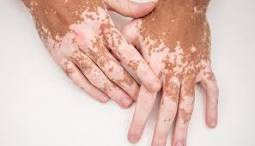
- Depigmented Patches: The primary symptom of vitiligo is the presence of depigmented or white patches on the skin. These patches can occur on any part of the body and can vary in size and shape. The patches may initially be small and gradually enlarge over time. The edges of the patches may be well-defined or irregular.
- Symmetrical Distribution: In many cases, vitiligo patches appear bilaterally or in a symmetrical pattern on both sides of the body. For example, if a patch develops on one hand, it is likely to appear on the corresponding area of the other hand as well.
- Common Sites of Involvement: While vitiligo can occur anywhere on the body, certain areas are more commonly affected. These include the face, hands, fingers, feet, elbows, knees, lips, genital area, and areas around body openings (such as eyes, nostrils, and mouth).
- Progression: Vitiligo is often a progressive condition, meaning that the white patches may spread or increase in size over time. New patches can appear while existing patches may expand. The rate of progression varies widely among individuals. In some cases, the condition may remain stable for long periods without significant changes.
- Hair Color Changes: In addition to skin depigmentation, vitiligo can also affect the color of hair. Hair in the affected areas may turn white or gray due to the loss of pigment. This change in hair color can occur on the scalp, eyebrows, eyelashes, and other body hair.
- Sun Sensitivity: The depigmented patches of vitiligo may be more susceptible to sunburn and damage from sun exposure. The affected skin may be more sensitive to sunlight and prone to sunburns. It is important to protect the skin with sunscreen and proper clothing when spending time outdoors.
- Emotional Impact: Vitiligo can have a significant psychological and emotional impact on individuals. The visible changes in the skin's appearance may lead to self-consciousness, decreased self-esteem, and anxiety. Coping with the emotional aspects of vitiligo and seeking support from healthcare professionals, support groups, or counseling can be beneficial.
Reasons for Depigmentation or Loss of skin Pigment
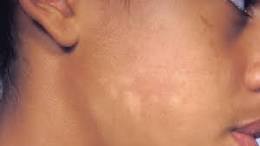 White patches on the skin, also known as hypopigmentation or depigmentation, can occur due to various underlying causes.
These causes can range from genetic factors to autoimmune conditions. Here is a detailed note on some of the common causes of white patches on the skin:
White patches on the skin, also known as hypopigmentation or depigmentation, can occur due to various underlying causes.
These causes can range from genetic factors to autoimmune conditions. Here is a detailed note on some of the common causes of white patches on the skin: - Vitiligo: Vitiligo is a skin disorder characterized by the destruction of melanocytes, the cells responsible for producing the pigment melanin. It leads to the formation of white patches on different areas of the body. The exact cause of vitiligo is still unknown, but it is believed to involve a combination of genetic, autoimmune, and environmental factors.
- Post-inflammatory hypopigmentation: This type of hypopigmentation occurs as a result of inflammation or injury to the skin. Inflammatory conditions like eczema, psoriasis, or allergic reactions can cause temporary or permanent loss of skin pigment in the affected areas.
- Tinea versicolor: Tinea versicolor is a fungal infection that affects the skin. It is caused by the yeast Malassezia, which interferes with the normal pigmentation process. The infection leads to the formation of white, tan, or pinkish patches on the skin, typically on the chest, back, and shoulders.
- Pityriasis alba: Pityriasis alba is a common skin condition that primarily affects children and young adults. It is characterized by the presence of round or oval-shaped pale patches on the face, arms, and other sun-exposed areas. The exact cause is unclear, but it is believed to be associated with dry skin, sun exposure, or a mild form of eczema.
- Albinism: Albinism is a genetic condition that affects the production of melanin. People with albinism have little to no pigment in their skin, hair, and eyes, resulting in white or very light-colored skin patches. Albinism is a rare condition and is usually present from birth.
- Halo nevus: A halo nevus is a type of mole that is surrounded by a depigmented or hypopigmented halo. The cause of halo nevus is not fully understood, but it is believed to be related to an immune response against the mole or melanocytes.
- Autoimmune conditions: Certain autoimmune disorders, such as autoimmune thyroid disease, may be associated with the development of white patches on the skin. In these cases, the immune system mistakenly attacks and destroys melanocytes, leading to depigmentation.
Is vitiligo genetic?
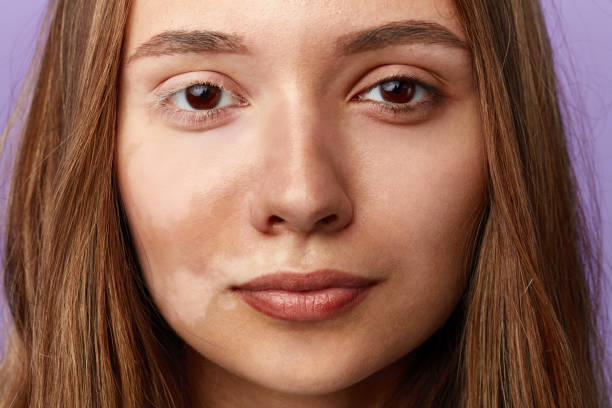 Vitiligo is considered to have a multifactorial etiology, meaning that both genetic and environmental factors play a role in its development. While the exact cause of vitiligo is not fully understood, research suggests a strong genetic component.
Vitiligo is considered to have a multifactorial etiology, meaning that both genetic and environmental factors play a role in its development. While the exact cause of vitiligo is not fully understood, research suggests a strong genetic component. Studies have indicated that certain genetic variations or mutations may increase the risk of developing vitiligo. Several genes have been identified that are associated with an increased susceptibility to vitiligo, including genes involved in immune regulation, melanocyte function, and melanin production.
It has been observed that vitiligo tends to run in families, suggesting a hereditary component. Individuals with a family history of vitiligo are more likely to develop the condition themselves. However, it's important to note that having a genetic predisposition does not guarantee the development of vitiligo, as other factors, such as environmental triggers, are also involved.
The inheritance pattern of vitiligo is complex and can vary. It does not follow a simple Mendelian pattern of inheritance like some genetic disorders. Rather, it is believed to involve the interplay of multiple genes, each contributing a small effect. The risk of developing vitiligo is influenced by a combination of genetic factors, including variations in multiple genes, as well as non-genetic factors, such as exposure to certain triggers, autoimmune dysfunction, and environmental factors.
It is worth mentioning that not everyone with a genetic predisposition to vitiligo will develop the condition, and the presence of vitiligo in one individual within a family does not necessarily mean that other family members will be affected. The exact interaction between genetic factors and environmental triggers in the development of vitiligo is still an area of ongoing research.
In summary, while vitiligo has a genetic component and individuals with a family history of the condition may have an increased risk, the development of vitiligo is influenced by a combination of genetic, environmental, and immune factors. Further research is needed to fully understand the genetic mechanisms involved in vitiligo and their interactions with other factors.
Leucoderma Treatment and Vitiligo Treatment?
- Clinical Features: Both Vitiligo and Leucoderma consist of white patches which can only be differentiated by the cause. In some patients, the raised patches could be evident of Leucoderma without using a source of light, even though it is quite hard to differentiate.
- Vitiligo is mainly caused by autoimmune conditions, hormonal changes, acute emotional trauma or stress, recurrent episodes of Jaundice or Typhoid fever, prolonged Antibiotic treatments or corticosteroid treatment.
- Leucoderma will strictly occur following a physical trauma such as cut, burn or ulceration. The scar which will then form will ultimately convert into a white patch which might sometimes enlarge in size over time.
White spots on skin
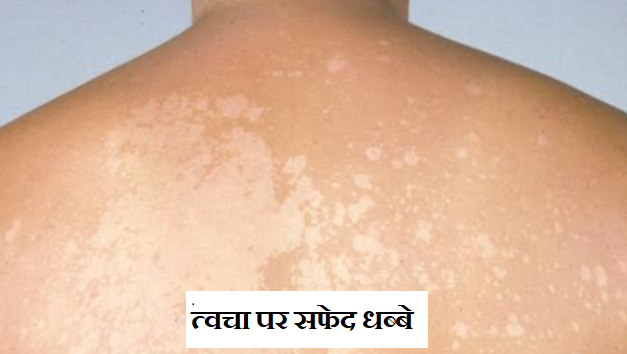 Every white patch is not Vitiligo.
It is essential to understand that white patches in the skin may be due to various causes like birth marks, post burns or some disease, due to some chemicals etc.
White spots on the skin can be caused by allergies and nutritional deficiencies.
Generally, a white patch on your skin isn’t a cause for concern.
A doctor can help determine the cause and treatment options.
Every white patch is not Vitiligo.
It is essential to understand that white patches in the skin may be due to various causes like birth marks, post burns or some disease, due to some chemicals etc.
White spots on the skin can be caused by allergies and nutritional deficiencies.
Generally, a white patch on your skin isn’t a cause for concern.
A doctor can help determine the cause and treatment options. Is Vitiligo at all contagious?
No. Because if it was so then many more people in the world including the treating doctors and family members of Vitiligo patients would have developed Vitiligo.Vitiligo Cure - Treatment for Loss of Skin Pigmentation
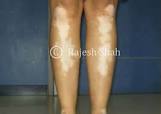
- Topical Corticosteroids: Corticosteroid creams or ointments are often prescribed as a first-line treatment for localized vitiligo. These medications help to reduce inflammation and suppress the immune response in the affected areas, allowing repigmentation to occur. Treatment with corticosteroids may require several months to see noticeable results, and long-term use should be monitored by a healthcare professional due to potential side effects.
- Topical Calcineurin Inhibitors: Calcineurin inhibitors, such as tacrolimus and pimecrolimus, are immune-modulating creams that can be used to treat vitiligo. They work by reducing inflammation and immune activity in the skin. Calcineurin inhibitors are typically recommended for use on the face and other sensitive areas where corticosteroids may pose risks. Regular application over a period of months may help induce repigmentation.
- Topical Psoralen Plus Ultraviolet A (PUVA): PUVA involves the combination of a topical application of psoralen, a photosensitizing medication, followed by exposure to ultraviolet A (UVA) light. Psoralen makes the skin more responsive to UVA, which stimulates repigmentation. This treatment is most effective for generalized vitiligo and requires multiple sessions over several months. PUVA carries risks, such as sunburn and increased skin cancer risk, so it should be closely monitored by a dermatologist.
- Narrowband Ultraviolet B (NB-UVB) Phototherapy: NB-UVB phototherapy involves exposure to a specific wavelength of ultraviolet B (UVB) light, which stimulates repigmentation in the skin. It is considered a safe and effective treatment for vitiligo and can be used for localized or generalized vitiligo. Treatment sessions are typically conducted two to three times per week, and it may take several months to see noticeable improvement.
- Excimer Laser: Excimer lasers deliver a targeted beam of UVB light to the affected areas of the skin. This treatment is similar to NB-UVB phototherapy but allows for precise targeting of vitiligo patches. Excimer laser treatment is most effective for small areas of vitiligo and typically requires multiple sessions.
- Surgical Options: In cases where other treatments have not been successful, surgical options may be considered. These include techniques such as skin grafting, blister grafting, and melanocyte transplantation. These procedures involve the transfer of melanocytes from unaffected areas of the body to the depigmented areas, promoting repigmentation. Surgical treatments are often reserved for stable vitiligo, where the spread of depigmentation has ceased.
It's worth mentioning that vitiligo treatment focuses on managing the condition and achieving repigmentation. However, complete and permanent repigmentation is not always possible, and treatments may not be effective for everyone. Psychological support and counseling may be beneficial for individuals with vitiligo to cope with the emotional impact of the condition.
It is recommended to consult with a dermatologist or healthcare professional to discuss the available treatment options, potential risks, and benefits, and to develop a personalized treatment plan for vitiligo.
Are diet and Vitiligo related?
Vitiligo does not occur due to any dietary deficiency. There is no scientific basis to prove that any specific type of food (including white dietary products) causes or worsens Vitiligo.Is it advisable for a person with Vitiligo to marry?
There is no reason not to marry a person with Vitiligo. It is not infectious at all. Again, please remember that Vitiligo is not a disease but a cosmetic problem only, and it is we who have to remove the stigma attached to it from our minds.How long does it take to treat Vitiligo?
It is difficult to state definitely, as each patient shows variable response at a variable pace. The duration of treatment ranges between 6 months to many years.Treatment options afor Vitiligo or White Patches
Presently there are number of treatment options available –including steroid creams, immunomodulators like tacrolimus or pimecrolimus, PUVA therapy, UVB therapy.Relatively newer modalities of treatment are narrow brand UVB and surgical treatment like skin grafting, and pigment transplantation.Are there any cosmetics available to cover-up Vitiligo spots?
Nowadays, a number of camouflage creams are available which can be selected and applied over Vitiligo patches to match the patient's natural skin colour as closely as possible. However these creams are of temporary nature, their benefit ranging from few hours to few days.Related Video
Book your appointmnet for the Vitiligo Treatment here : Book Your Appointment






